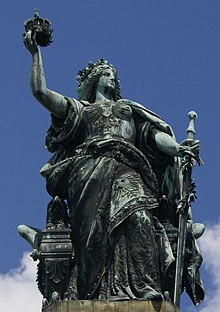
Back جرمانيا (تجسيد) Arabic Xermania (personificación) AST Германия (персонификация) Bulgarian Germania (alegorienn) Breton Germania (personifikation) Danish Germania (Personifikation) German Germania (personigo) Esperanto Germania (personificación) Spanish Germania (allegooria) Estonian Germania (pertsonifikazioa) Basque


Germania (/dʒərˈmeɪniə/; Latin: [ɡɛrˈmaːnia]) is the personification of the German nation or the Germans as a whole. Like many other national personification symbols, she appeared first during the Roman Era.[1] During the Medieval era, she was usually portrayed as one of the lands or provinces ruled by the emperors of the Holy Roman Empire, and not as the most prominent but in a subordinate position to imperial power and other provinces.[2] Around 1500, together with the birth of the Holy Roman Empire of the German Nation, Emperor Maximilian I and his humanists reinvented her as Mother of the Nation.[1][3]
She is also commonly associated with the Romantic Era and the Revolutions of 1848, though the figure was later used by Imperial Germany.
- ^ a b Colvin & Watanabe-O'Kelly 2009, p. 90.
- ^ Brandt 2010, pp. 35–43.
- ^ Watanabe-O'Kelly 2010, p. 9.